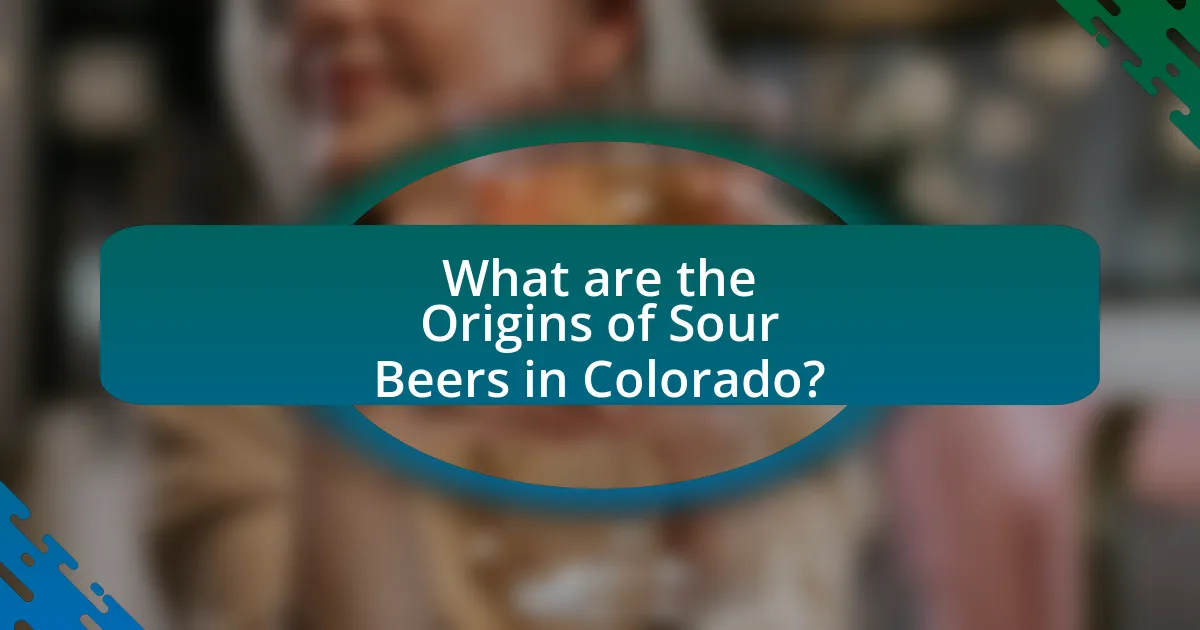The article examines the evolution of sour beers within Colorado’s craft beer scene, tracing their origins back to the early 1990s and the influence of Belgian brewing traditions. It highlights key breweries, such as New Belgium Brewing, that pioneered sour styles and discusses the emergence of diverse flavors and fermentation techniques that have shaped the current landscape. The article also addresses consumer preferences, innovative brewing methods, and the challenges and opportunities faced by sour beer producers, emphasizing the growing popularity and market demand for these unique beverages. Additionally, it provides insights for homebrewers interested in creating their own sour beers.

What are the Origins of Sour Beers in Colorado?
Sour beers in Colorado originated in the early 1990s, influenced by the Belgian brewing tradition that emphasizes wild yeast and bacteria fermentation. The introduction of sour styles was spearheaded by craft breweries like New Belgium Brewing, which began experimenting with sour ales in 1998, notably their La Folie, a Flanders-style sour brown ale. This pioneering effort laid the groundwork for a growing interest in sour beers across the state, leading to a diverse range of styles and flavors as more breweries adopted sour brewing techniques. The rise of sour beers in Colorado reflects a broader trend in the craft beer movement, where innovation and experimentation are key drivers of growth.
How did sour beer styles emerge in the craft beer scene?
Sour beer styles emerged in the craft beer scene primarily due to a growing interest in diverse flavors and fermentation techniques among brewers. In the late 20th century, craft breweries began experimenting with wild yeast strains and bacteria, such as Lactobacillus and Brettanomyces, which are essential for producing sour flavors. This experimentation was influenced by traditional European brewing practices, particularly those from Belgium and Germany, where sour beers like Lambics and Berliner Weisse have long been popular. The rise of the craft beer movement in the United States, particularly in regions like Colorado, fostered an environment where innovation and unique flavor profiles were encouraged, leading to the proliferation of sour beer styles. By 2015, the Brewers Association reported that sour beers accounted for approximately 1% of the overall craft beer market, reflecting their growing acceptance and popularity among consumers.
What historical influences shaped the development of sour beers?
Sour beers developed primarily due to historical brewing practices that embraced wild fermentation and the use of specific microorganisms. In ancient times, brewers in regions like Belgium and Germany utilized spontaneous fermentation, allowing naturally occurring yeast and bacteria to sour the beer, which was a common method before the advent of controlled brewing techniques. The Lambic style from Belgium, for instance, showcases this tradition, where open-air fermentation leads to complex sour flavors. Additionally, the introduction of souring techniques in the 19th century, such as the use of lactobacillus and pediococcus, further influenced the production of sour beers, allowing for more consistent and intentional sourness. These historical practices laid the foundation for the modern craft beer movement, particularly in places like Colorado, where breweries now experiment with various souring methods to create unique flavors.
Which early breweries played a pivotal role in introducing sours?
Early breweries that played a pivotal role in introducing sours include New Belgium Brewing Company and Boulevard Brewing Company. New Belgium, founded in 1991, was one of the first American breweries to focus on sour beers, particularly with its flagship beer, La Folie, which is a Flanders-style sour ale. Boulevard Brewing Company, established in 1989, also contributed significantly to the sour beer movement with its Smokestack Series, particularly the Tank 7 Farmhouse Ale, which incorporates sour elements. Both breweries have been influential in popularizing sour styles in the craft beer scene, especially in Colorado, where the craft beer culture has thrived.
What are the key characteristics of sour beers?
Sour beers are characterized by their tart and acidic flavors, which result from the fermentation process involving wild yeast strains and bacteria. These beers often exhibit a range of flavors, including fruity, funky, and sometimes earthy notes, due to the presence of lactic acid bacteria such as Lactobacillus and Brettanomyces yeast. The sourness can vary significantly, with some sour beers being mildly tart while others are intensely sour. Additionally, sour beers may incorporate various fruits and spices, enhancing their complexity and aroma. The brewing techniques, such as barrel aging and blending, further contribute to the unique profiles of sour beers, making them distinct within the craft beer landscape.
How do fermentation processes differ in sour beers compared to other styles?
Fermentation processes in sour beers differ significantly from other styles primarily due to the use of wild yeast and bacteria, such as Brettanomyces and Lactobacillus, which contribute to the sour flavor profile. In contrast, traditional beer styles typically rely on cultivated yeast strains like Saccharomyces cerevisiae, which ferment sugars without producing lactic acid. This difference in microbial activity leads to distinct flavor characteristics; sour beers often exhibit tartness and complexity, while other styles maintain a cleaner, more straightforward taste. The fermentation duration also varies, with sour beers often undergoing longer aging periods to develop their unique profiles, as seen in many Belgian lambics and American wild ales.
What ingredients are commonly used in crafting sour beers?
Sour beers are commonly crafted using ingredients such as malted barley, hops, yeast, and various fruits. The malted barley provides the base for the beer, while hops contribute bitterness and aroma. Yeast, particularly wild strains like Brettanomyces and Lactobacillus, is crucial for developing the sour flavors through fermentation. Additionally, fruits like cherries, raspberries, and peaches are often added to enhance the complexity and tartness of the beer. These ingredients work together to create the distinctive sour profile that characterizes this style.
What Trends are Currently Shaping Colorado’s Sour Beer Scene?
The current trends shaping Colorado’s sour beer scene include an increased focus on local ingredients, innovative fermentation techniques, and a growing consumer interest in unique flavor profiles. Breweries are sourcing local fruits and grains to create distinct regional flavors, enhancing the authenticity of their sour beers. Additionally, many breweries are experimenting with mixed fermentation processes, incorporating wild yeast strains and bacteria to develop complex flavors. This trend is supported by the rise in popularity of barrel-aging, where sour beers are aged in various types of barrels to impart additional character. The Colorado craft beer market has seen a significant increase in sour beer offerings, with a reported 30% growth in sour beer production from 2020 to 2023, reflecting the evolving tastes of consumers who seek adventurous and diverse drinking experiences.
How have consumer preferences evolved regarding sour beers?
Consumer preferences regarding sour beers have evolved significantly, with a marked increase in popularity over the past decade. Initially, sour beers were niche products primarily enjoyed by a small segment of craft beer enthusiasts; however, recent trends indicate a broader acceptance and demand among mainstream consumers. According to the Brewers Association, sales of sour beers grew by 25% from 2019 to 2020, reflecting a growing interest in diverse flavor profiles and unique brewing techniques. This shift is further evidenced by the increasing number of breweries in Colorado and beyond that are incorporating sour styles into their offerings, catering to a wider audience seeking innovative and complex taste experiences.
What demographic factors influence the popularity of sour beers?
The popularity of sour beers is influenced by demographic factors such as age, gender, and geographic location. Younger consumers, particularly those aged 21 to 35, show a higher preference for sour beers, as they are more open to trying innovative and unique flavors compared to older generations. Additionally, studies indicate that men are more likely to experiment with sour beers than women, although the gap is narrowing as more women enter the craft beer market. Geographic location also plays a significant role; regions with a strong craft beer culture, like Colorado, tend to have higher consumption rates of sour beers due to the availability of local breweries specializing in this style.
How do flavor profiles in sour beers appeal to modern drinkers?
Flavor profiles in sour beers appeal to modern drinkers by offering unique and complex taste experiences that differ significantly from traditional beer styles. These profiles often include tartness, fruitiness, and earthy notes, which cater to the adventurous palates of contemporary consumers seeking variety and novelty in their drinking experiences. The rise of craft breweries in Colorado has further fueled this trend, with many breweries experimenting with wild yeast strains and barrel-aging techniques, resulting in a diverse range of sour beers that attract enthusiasts. According to the Brewers Association, sour beer sales have increased by over 30% in recent years, indicating a growing demand among drinkers for these distinctive flavors.
What innovative brewing techniques are being adopted?
Innovative brewing techniques being adopted in Colorado’s craft beer scene include the use of spontaneous fermentation, barrel-aging with unique wood types, and the incorporation of fruit and botanicals during the brewing process. Spontaneous fermentation, which relies on wild yeast and bacteria from the environment, enhances the complexity of sour beers. Barrel-aging in various wood types, such as oak or cherry, adds distinct flavors and aromas, while the addition of fruits like peaches or botanicals like lavender creates unique flavor profiles. These techniques reflect a growing trend towards experimentation and creativity in brewing, as evidenced by the increasing number of breweries embracing these methods to differentiate their offerings in a competitive market.
How are local breweries experimenting with barrel aging and wild yeasts?
Local breweries are experimenting with barrel aging and wild yeasts by creating unique flavor profiles and enhancing the complexity of their sour beers. This process involves aging beers in previously used barrels, which can impart flavors from the wood and any previous contents, while wild yeasts, such as Brettanomyces, contribute to distinctive fermentation characteristics. For instance, breweries like Crooked Stave and Avery Brewing in Colorado have embraced these techniques, resulting in a diverse range of sour ales that showcase the interplay between the barrel’s influence and the wild yeast’s fermentation traits. This experimentation not only reflects a growing trend in the craft beer scene but also aligns with consumer demand for innovative and artisanal products.
What role do collaborations between breweries play in trend development?
Collaborations between breweries significantly influence trend development by fostering innovation and expanding flavor profiles. When breweries partner, they combine unique brewing techniques and ingredients, which often leads to the creation of new styles or variations of existing ones. For instance, collaborations have been pivotal in the rise of sour beers in Colorado, as breweries experiment with different fermentation processes and local ingredients, resulting in diverse offerings that attract consumer interest. This collaborative approach not only enhances creativity but also encourages knowledge sharing, which can accelerate the adoption of new trends within the craft beer community.

What Challenges and Opportunities Exist for Sour Beer Producers?
Sour beer producers face challenges such as maintaining consistent quality and managing the complexities of fermentation, while opportunities include tapping into a growing consumer interest in unique flavors and health benefits associated with sour beers. The variability in wild yeast and bacteria used in sour beer production can lead to unpredictable results, making quality control a significant hurdle. However, the increasing popularity of craft beer, particularly among millennials who seek diverse and innovative options, presents a substantial market opportunity. According to the Brewers Association, sour beer sales have seen a notable rise, indicating a shift in consumer preferences that sour beer producers can capitalize on.
What are the common challenges faced by breweries producing sour beers?
Breweries producing sour beers commonly face challenges such as contamination, inconsistent fermentation, and longer production times. Contamination is a significant issue because sour beers often utilize wild yeast and bacteria, which can lead to unintended flavors if not properly managed. Inconsistent fermentation occurs due to the unpredictable nature of wild yeast strains, making it difficult to achieve a consistent product. Additionally, the production of sour beers typically requires longer aging periods, which can strain resources and inventory management. These challenges are well-documented in brewing literature, highlighting the complexities involved in sour beer production.
How do production costs impact the pricing of sour beers?
Production costs significantly influence the pricing of sour beers due to the unique ingredients and lengthy fermentation processes involved. Sour beers often require specialized grains, yeast strains, and sometimes fruit, which can be more expensive than those used in traditional beers. Additionally, the extended aging process, sometimes lasting several months to years, incurs higher storage and labor costs. For instance, a study by the Brewers Association indicates that the average production cost for sour beers can be 20-30% higher than for standard beers, directly affecting their retail price. This correlation between production costs and pricing ensures that consumers pay a premium for the complexity and craftsmanship inherent in sour beers.
What quality control measures are essential for sour beer production?
Essential quality control measures for sour beer production include monitoring pH levels, controlling fermentation temperatures, and conducting regular microbial testing. Monitoring pH levels is crucial as sour beers typically have lower pH due to lactic acid production, which affects flavor and stability. Controlling fermentation temperatures ensures that yeast and bacteria function optimally, preventing off-flavors and undesirable microbial growth. Regular microbial testing is necessary to identify and quantify the presence of specific strains of yeast and bacteria, ensuring the desired sourness and preventing contamination. These measures are supported by industry practices that emphasize the importance of maintaining consistent quality in sour beer production.
What opportunities can breweries leverage in the sour beer market?
Breweries can leverage opportunities in the sour beer market by capitalizing on the growing consumer interest in unique and complex flavors. The sour beer segment has seen a significant increase in popularity, with a 20% growth in sales from 2019 to 2021, indicating a strong market demand. Additionally, breweries can experiment with local ingredients and innovative brewing techniques, such as barrel-aging and wild fermentation, to create distinctive products that appeal to adventurous drinkers. Collaborations with local farms for fruit sourcing can also enhance the flavor profiles of sour beers, further attracting consumers looking for locally-sourced options.
How can breweries effectively market their sour beer offerings?
Breweries can effectively market their sour beer offerings by leveraging unique flavor profiles and engaging storytelling. Highlighting the distinct characteristics of sour beers, such as their tartness and complexity, can attract consumers looking for new taste experiences. Additionally, breweries can utilize social media platforms to share behind-the-scenes content about the brewing process, which fosters a connection with potential customers. According to a 2022 survey by the Brewers Association, 60% of craft beer drinkers are interested in trying innovative flavors, indicating a strong market for sour beers. Collaborating with local food pairings and hosting tasting events can further enhance visibility and consumer interest in sour offerings.
What role does community engagement play in promoting sour beers?
Community engagement plays a crucial role in promoting sour beers by fostering a sense of belonging and shared experience among enthusiasts. Local breweries often host events, tastings, and educational sessions that encourage interaction and collaboration within the community, which helps to demystify sour beers and attract new consumers. For instance, breweries like Crooked Stave in Colorado have successfully utilized community engagement strategies, such as inviting local homebrewers to showcase their sour creations, thereby enhancing interest and appreciation for the style. This active participation not only builds loyalty but also creates a vibrant culture around sour beers, leading to increased sales and a broader market presence.
What Tips Can Homebrewers Follow to Create Their Own Sours?
Homebrewers can create their own sours by incorporating wild yeast and bacteria, such as Lactobacillus and Brettanomyces, into their brewing process. These microorganisms are essential for developing the tart and complex flavors characteristic of sour beers. Additionally, using a mixed fermentation approach, where both traditional yeast and wild yeast are present, can enhance the depth of flavor. It is also beneficial to experiment with different fruits and spices during fermentation, as they can contribute unique flavors and aromas. The use of oak barrels for aging can further add complexity, as the wood interacts with the beer over time. These practices align with the growing trend of sour beers in Colorado’s craft beer scene, where innovation and experimentation are highly valued.
What essential equipment is needed for brewing sour beers at home?
To brew sour beers at home, essential equipment includes a fermentation vessel, an airlock, a hydrometer, a thermometer, and bottles for storage. The fermentation vessel, typically a glass carboy or food-grade plastic bucket, allows for the fermentation process while preventing contamination. An airlock is crucial for releasing gases during fermentation while keeping out unwanted microorganisms. A hydrometer measures the specific gravity of the beer, helping to determine alcohol content and fermentation progress. A thermometer ensures that the brewing temperature is optimal for yeast and bacteria activity. Finally, bottles are necessary for storing the finished sour beer, often requiring caps or corks for sealing. This equipment is fundamental for successfully creating sour beers, which rely on specific fermentation techniques and conditions.
How can homebrewers experiment with flavors in their sour creations?
Homebrewers can experiment with flavors in their sour creations by incorporating various fruits, spices, and herbs during fermentation. For instance, adding fruits like raspberries or peaches can enhance the tartness and complexity of the sour beer, as these ingredients contribute natural sugars and acids that interact with the yeast and bacteria. Additionally, using spices such as coriander or ginger can introduce unique flavor profiles, while herbs like basil or mint can add freshness. The process of barrel aging with different wood types can also impart distinct flavors, as the wood interacts with the beer over time. This method of flavor experimentation is supported by the growing trend in Colorado’s craft beer scene, where breweries are increasingly using local ingredients to create innovative sour beers that reflect regional tastes and preferences.


